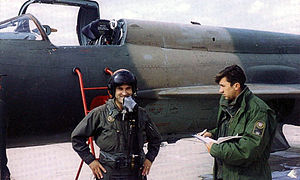Croatian Air Force – Future
FLIGHT ACADEMY AND ‘KRILA OLUJE (WINGS OF STORM)’
After passing a screening process, Croatian cadets attend university for five semesters before returning to Zadar for another four semesters and initial flying training on Zlin 242Ls with the Eskadrila aviona (EA, aircraft squadron). After some 40 hours they progress to either the PC-9M in the same squadron, or to the Bell 206B-3 for basic helicopter training with the Eskadrila helikoptera (EH, helicopter squadron).
In the early years after the Homeland War the ‘Rudolf Perisin’ Air Force Academy maintained three squadrons: one with UTVA-75s and PC-9Ms for basic training, one with PC-9Ms for advanced training and one helicopter squadron. With annual numbers of cadets decreasing, the two fixed-winged squadrons merged, pooling both the Zlin 242L and PC-9M in a single unit.
Founded in 2005 by instructors of the Air Force Academy, the Krila Oluje (Wings of Storm) display team flies six PC-9Ms. The team’s name refers to Operation ‘Storm’ (Operacija’Oluja’), when Croatian and Bosnian forces retook part of Croatia previously occupied by ethnic Serbs in early August 1995.
The six aircraft (plus one spare) for Krila Oluje are drawn from the 17-aircraft PC-9M pool of the ‘Eskadrila aviona’ at Zadar-Zemunik. Budget permitting, use of a low-cost smoke system is under consideration to make the performance more eye-catching.
Krila Oluje marks its sixth season during 2011 with appearances in airshows at Izmir-Cigli (June), Zeltweg (July) and Radom (August).
RADAR NETWORK AND AIR DEFENSE
Croatia made early efforts to invest in a new nationwide radar system. In 1998 five units of the Lockheed Martin AN/FPS-117 phasedarray, 3D radar system were purchased, and these became fully operational in 2009. Each radar operator can monitor the entire country, as well as all civil and military flight movements. Beside the HRZ, the Croatian Navy also operates four Peregrine coastal radar systems from Metric Systems, in order to keep watch over the 1,246 islands and a 1,777km coastline.
The HRZ long maintained a small air defense element (Protuzračna Obrana, PZO). Most recently this consisted of short-range Strela-10 CRO A1 surface-to-air missiles mounted on 6×6 armored truck chassis and on the 4×4 BOV POLO M 83 armored personnel carrier. These activities have since been handed over to the Croatian Army. The Army is also responsible for the operation of the unmanned aerial vehicle fleet. In 2007-08 six Elbit Skylarks and two Elbit Hermes 450s were purchased.
In the past there have been rumors of Croatia operating a S-300 surface-to-air missile system. An incomplete system was purchased during the Homeland War and was displayed once before efforts were made to sell it abroad.
THE FUTURE
 As it begins its third decade, the Croatian AF continues to adapt from the old Yugoslav days and the post-Homeland War era to become fully NATO-compatible.
As it begins its third decade, the Croatian AF continues to adapt from the old Yugoslav days and the post-Homeland War era to become fully NATO-compatible.
Alongside these steps, new acquisitions are inevitable. The discussion surrounding a MiG-21 successor has now been ongoing for some years. Considering the current financial climate, such discussions are likely to continue in the near future.
The options are to procure either new or second-hand aircraft. While former Luftwaffe F-4F-s or Spanish AF Mirage F1-s may be made available practically for free, their high operational costs are among the reasons they are being retired in the first place! A costly solution such as the Tranche 1 Eurofighter Typhoon is unrealistic for Croatia, especially with continued question marks over operational costs.
The MiG squadron received a visit from a Russian delegation early this year. Unsurprisingly, they found the remaining airframes to be in poor condition. The Russians were unhappy with the Romanian upgrade and in return offered their own MiG-21-93 update, which no other operator has selected.
More realistic offers are from Lockheed Martin, which has proposed 10 F-16A and two F-16B Block 15 aircraft at a cost of around $400 million, and Saab, which has offered a squadron of Gripens with very attractive off-set conditions.
The same question has to be asked about the future of transport aviation, as the two An-32s will require replacement by more modern types. Although new C-27s or second-hand C-130s would be attractive, the availability of funds for such a project remains the key issue.
As a modem European society, Croatia will also have to find a way of offering its military pilots a decent career. The HRZ will require plenty of pilots to operate its fleet in accordance with constitutional rights in the future. This involves not only defending Croatian airspace in line with the constitution but also enabling the required service throughout the fire season. These goals cannot be achieved overnight, and there is some hard work awaiting the new air force commander.

Comments are closed, but trackbacks and pingbacks are open.